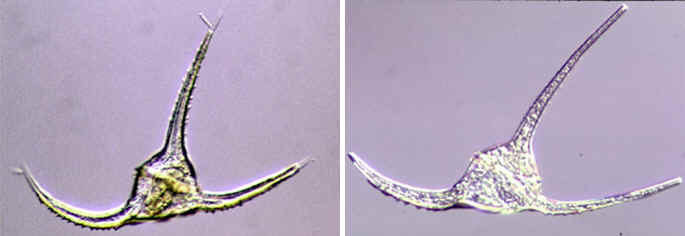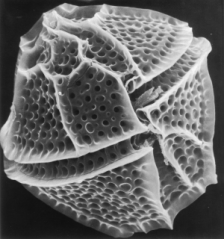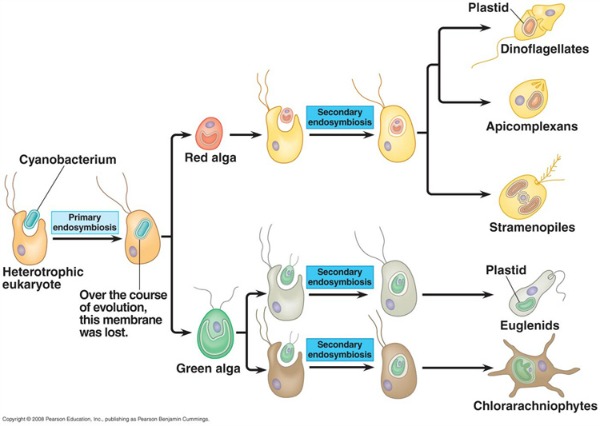
Classification
Domain:
Eukaryota
Kingdom:
Protozoa
Phylum: Dinophyta
Class: Dinophyceae
Order: Gonyaulacales
Family: Gonyaulacaceae
Genus: Gonyaulax
Species:
Gonyaulax catenella
©Yasuwo Fukuyo
Eukarya: Gonyaulax is a protist, and thus
classified as a eukaryote. It
possesses membrane bound organelles and a true nucleus. Check out
another eukaryotic organisms such as
Lilly of the Valley and
Solenodon paradoxus!
Protozoa: This eukaryotic
kingdom contains many unicellular organisms. Its singular form
protozoon follows the Greek meaning of proto= first and
zoon=animal. Ultimately meaning first animal. Under this kingdom
various other supergroups can be found, categorizing a vast variety
of organisms. These can range from multicellular red alga stalks to
unicellular phytoplankton. Gonyaulax catenella is classified as such
because of it's eukaryotic trait, ability to move, and some
organelles such as cholorplasts. with many unusual characteristics not
found in other groups.
Dinophyceae:

Dinophyceae are dinoflagellate organisms that live in all types of aquatic
ecosystems. Many of the species in the group are photosynthetic.
Gonyaulax catenella is one of those species. The others are exclusively
heterotrophic. There are members of the phytoplankton and
zooplankton of marine and freshwater ecosystems in this group. The
nucleus of a large majority of dinoflagellates is different from
other eukaryotic nuclei—dinokaryon.
Dinokarya lack a nucleosomse,
and
DNA content is larger than that of
other eukaryotic cells.
© 2004 Mona Hoppenrath.
Gonyaulacales
They are armored, while
almost
all of them contain chloroplasts, only some of the
under the order of Gonyaulaces can produce toxins and red tides.
They are distinguished by the arrangement and number of thecal
plates and how the tabulation is derived. Thus far, 344 species have
been categorized as a part of Gonyaulacales. The family Gonyaucaceae
follows these same characteristics.

©Yasuwo Fukuyo
Gonyaulax:
Gonyaulax catenella are single celled aquatic
organisms that are characterized by closely fitting cellulose plates
and have two flagella. One extends backward, and the other in an
encircling groove. They don't have an stigma and contain chromatophore pigments that range from yellow to brown. Some have an
apical horn or posterior spines. Take a look at the
Blue Ringed Octopus to learn about its chromatophore pigments!
Gonyaulax catenella:
These
organisms are a
toxic planktonic form of Gonyaulax. Sometimes they are abundant
enough to color water and cause red tide. Humans my also be poisoned
by marine life that have ingested G. catenlla. They have a
rounded apex and the thecal plates are thin and lightly porulated.
The nucleus is U- shaped. Gonyaulax catenella is synonymous
to Alexandrium catenella. Throughout the rest of this
website, Alexandrium and Gonyaualx catenlla will
be used interchangeably.
© 1999 Allison Arnold and Monica Draghici
In this polyphyletic
tree, it shows the lineage of the evolution of plastida. It is
generally stated that all organisms with chloroplasts and or
plastids share a single
ancestor that engulfed a cyanobacterium 600-1600 million years ago.
In protists such as Euglenozoa, chloroplasts have evolved through a
secondary endosymbiosis. In this situation the chloroplast may form
with three or four membrane layers. Dinoflagellates also have three
membrane layers around their chloroplast. This tree shows that
dinoflagellates have ancestors of cyanobacteria on a cellular level.
They are also related to other protists through a red alga, and thus
a dinoflagellates descended from the kingdom Alveolates. Ultimately
this tree shows dinoflagellates, meaning Gonyaulax catenella having an algal and cyanobacterium
ancestors.

© 2008 Pearson Benjamin Cummings
Click
here to check out a cyanobacterium ancestor!
Interested in knowing where Gonyaulax catenella resides?
Click to follow the Habitat page.